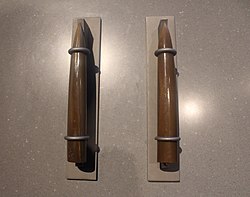Biology:Cylindroteuthis
| Cylindroteuthis | |
|---|---|

| |
| Fossil guards at the Field Museum of Natural History | |
| Scientific classification | |
| Kingdom: | Animalia
|
| Phylum: | |
| Class: | |
| (unranked): | |
| Order: | |
| Genus: | †Cylindroteuthis
|
Cylindroteuthis is a genus of belemnite that lived from the Early Jurassic to the Early Cretaceous. Its fossils have been found in Asia, Europe, North America, and New Zealand.
Taxonomical history
Cylindroteuthis was first described in 1879 by Claude-Emile Bayle.[2] A belemnite originally described as the Cylindroteuthis species C. confessa has been re-described as Mesoteuthis soloniensis.[3]
Paleobiology
Cylindroteuthis is a common find from several Jurassic formations. Specimen length ranges from 10 to 22 centimetres (4 to 8 1⁄2 inches). The most commonly preserved part of the animal is its guard, or rostrum, which was composed of calcite. The guard would not have been found on the exterior of Cylindroteuthis, as traces of blood vessels have been discovered on some guards, suggesting that it was an internal feature. The guard housed a phragmocone, which allowed Cylindroteuthis to maintain buoyancy in water. Some better-preserved specimens have features similar to modern squid, such as ten arm-like appendages and an ink sac, intact.[1]
Distribution
Cylindroteuthis has been recovered from the Temaikan Boatlanding Bay formation of Australasia.[4] Three species of Cylindroteuthis (C. knoxvillensis, C. cf. newvillensis, and C. venusta) have been described from the Arctic region.[5] In addition, about 2350 belemnite guards (including those of Cylindroteuthis) have been recovered from Lower Cretaceous formations of northeastern Greenland, suggesting the presence of a sort of "immigration route" for belemnites.[6] The findings also suggest the existence of a "proto Gulf-stream" as early as the Valanginian.[6] Another species, C. cf. obeliscoides is associated with the early Cretaceous One Tree Formation of Vancouver Island.[7]
References
- ↑ 1.0 1.1 Palmer, Douglas (2009). Prehistoric Life: The Definitive Visual History of Life on Earth (1st American ed.). New York: Dorling Kindersley. p. 238. ISBN 978-0-7566-5573-0.
- ↑ Cite error: Invalid
<ref>tag; no text was provided for refs namednomenclator - ↑ Dzyuba, O. S.; Nalnyaeva, T. I. (May 2011). "New species of Early Bajocian Megateuthididae (Belemnitida) from the Pacific coast of Russia". Paleontological Journal 45 (3): 260–265. doi:10.1134/S0031030111030051.
- ↑ Westermann, Gerd E. G. (2005). "Australasia". The Jurassic of the Circum-Pacific (illustrated ed.). Cambridge, New York: Cambridge University Press. p. 171. ISBN 0-521-01992-3. https://books.google.com/books?id=iMus4MtzIl4C&pg=PA171. Retrieved February 18, 2012.
- ↑ Dzyuba, O. S. (February 2012). "Belemnites and biostratigraphy of the Jurassic-Cretaceous boundary deposits of northern East Siberia: New data on the Nordvik Peninsula". Stratigraphy and Geological Correlation 20 (1): 53–72. doi:10.1134/S0869593811060037. Bibcode: 2012SGC....20...53D.
- ↑ 6.0 6.1 Alsen, Peter; Mutterlose, Jörg (September 2009). "The Early Cretaceous of North-East Greenland: A crossroads of belemnite migration". Palaeogeography, Palaeoclimatology, Palaeoecology 280 (1–2): 168–182. doi:10.1016/j.palaeo.2009.06.011. Bibcode: 2009PPP...280..168A.
- ↑ Ludvigsen, Rolf & Beard, Graham. 1997. West Coast Fossils: A Guide to the Ancient Life of Vancouver Island. pg. 93-94
- Fossils (Smithsonian Handbooks) by David Ward (Page 163)
External links
Wikidata ☰ Q4119243 entry
 |

